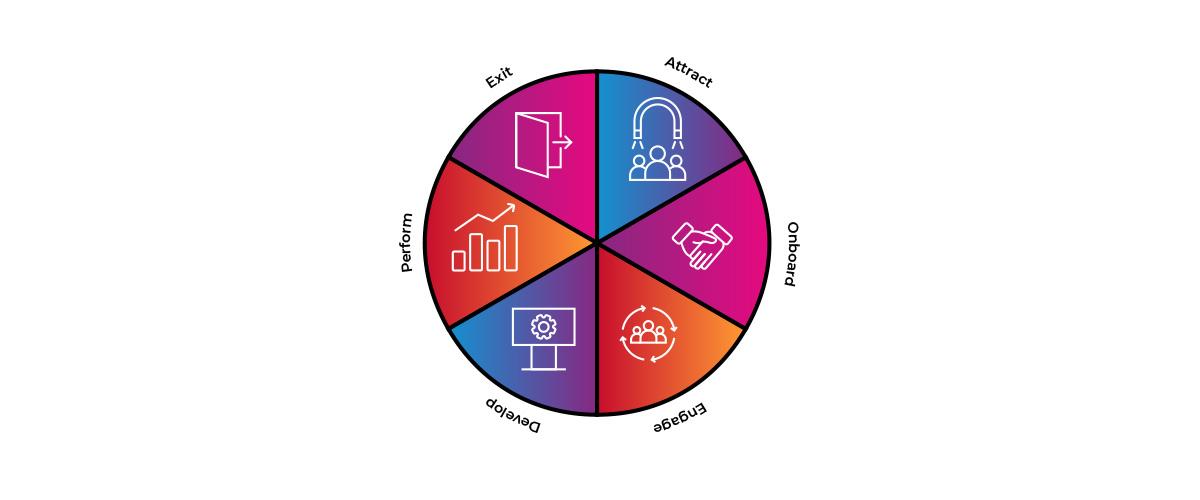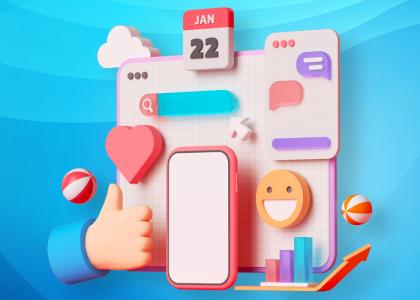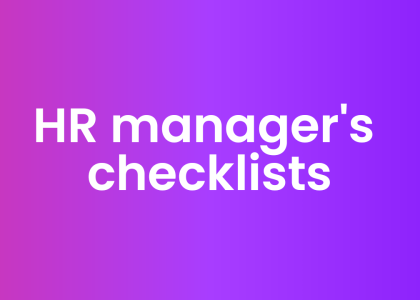Introduction
People are the most important part of any organisation, so ensuring they have a good experience from the moment they think about joining you to the moment they leave should form a key part of any business strategy.
With so much change in recent years and over 1,161,000 vacancies across the UK, unhappy employees are finding it very easy to look for work elsewhere. The Great Resignation of 2021 put these issues to the forefront, and they're not likely to go anywhere anytime soon.
This guide will ensure that you know how to create a great employee experience.
What is employee experience?
No matter what stage of the employee life cycle they’re at, your employees are experiencing a variety of feelings about your organisation. Whether they’re a potential candidate looking at your job listings or a current employee who’s tempted by greener pastures, the employee experience is a key aspect of your business.
It’s a wide-ranging concept. Not only does it include the tasks your employees undertake day to day, but it also includes the emotions they feel at work, the interactions they have with co-workers, and can even cover things like their commute to work that day.
All these factors can have a massive impact on your organisation. An employee’s experience will change how hard they work, and it will be a fundamental part of their decision-making if they decide to leave.
Why is employee experience important?
Only 13% of employees are fully satisfied with their experience at work. Our own research suggests that 90% of employees think more can be done to address emotional wellbeing. Over a third (38%) of employees are looking to change roles within the next six months, and many cite a poor employee experience as a large factor in this decision.
Pay is no longer the only thing employees care about. Employees want jobs that fit their lifestyle and give their life meaning and purpose. This is a big cause behind mass resignations. On average, it costs £3000 just to onboard a new employee. If you’re having to constantly look for new employees to replace those that have left due to a bad experience, those costs are going to rapidly increase.
Rebecca Carter, Product Owner for Talent and Engagement at MHR said, ‘Employee expectations are only likely to increase in the coming years. Businesses that don’t act now will find their employee turnover will get worse, reducing their resilience and harming their long-term growth’.
Employee experience now forms a huge part of your employer brand. Employees that are having a good experience will share these experiences with others, even after they've left you. The reverse is also true. In fact, employees who've had a bad experience are much more likely to share that. This can have a huge impact on your employer brand and make hiring in the future a lot more difficult.
What's the difference between employee experience and employee engagement?
While some people use employee experience and employee engagement interchangeably, they are in fact two distinct but entwined ideas.
If you think of employee experience as what an employee goes through day to day, employee engagement is how they feel about this, and how this impacts their ability to work.
What are some examples of employee experience?
Employee experience is a broad term that can cover a wide range of areas. We've selected a few that our research suggests employees find most important, although the aspects your employees value most may vary.
- Mental and emotional wellbeing. Do you encourage a healthy work-life balance?
- Financial wellbeing. If you can't offer pay rises, what about temporary cost-of-living support? What about earned wage access?
- Physical wellbeing. Can you subsidise healthy lunches or gym memberships?
- Social wellbeing. Are there opportunities for employees to interact outside of work, even if they're remote?
What are the benefits of employee experience?
Employee retention is the most cited benefit of a good employee experience, which is critical for overcoming skill gaps and ensuring you're not constantly recruiting replacements.
However, there are numerous other benefits to having improved your employee experience. Simply put, companies with an engaged workforce outperform companies that don't. Businesses with engaged workers see a 23% boost in profitability. They also see an 81% drop in absenteeism.
What is the role of HR in employee experience?
Your HR team will form a fundamental part of any employee experience strategy. Most of the issues that employees will face in the workplace will come down to HR fundamentals. Good managers, good pay packages, and training are all key components, and they are all matters that come back to HR.
Rebecca Carter says 'employee experience is everyone's responsibility, but HR departments are best suited to map out the key touchpoints and standards of your employee experience. When properly invested in and given the tools and time to succeed, they can lead the charge. They're also key to finding the right people who will match the organisation's goals and values, in addition to helping employees develop into great performers. That will reduce friction down the line. After that, managers, leaders and employees will be able to take responsibility more effectively.'
HR departments often struggle to find time for creating more high-level people-focused strategies, because so much of their time is spent on day-to-day administrative tasks. This can really damage the employee experience. With investment in tech that can automate these tasks and encourage employee self-service, you'll give your team more time while improving your employee experience across the board.
Listen to the People Systems and Employee Engagement episode of the MHR podcast to learn how the right HR tech can boost employee experience.
What are the different employee experience models?
An employee experience model is a framework that you can use to assess what your employees need and where your focus should be.
Here are a few models that you can use to get started, but we'd recommend customising them to your organisation's unique needs.
The JD-R Model
Designed in 2006 by Arnold Bakker and Evangelia Demerouti, the JD-R model is focused more on predicting cases of employee burnout. This takes a more specific problem and gives a framework for resolving it, instead of trying to cover a wide range of problems.
This model defines job demands (the emotional or physical burdens placed on an employee) as well as job resources (the tools, support systems, and processes that will help them manage those demands). The model aims to balance demands with resources, so things are optimised. Employees are given the support they need to avoid burning out, without the employer needing to overcompensate with resources that just waste money.
The Zinger Model
Created by management consultant David Zinger, this model focuses on the importance of employee connections to other employees, the company, their customers, the broader community, and to themselves.
The Zinger model can be visualised as a pyramid, with four key traits being identified as necessities that form the base. This gives the rest of the less essential needs a stable foundation to be built onto.
The Deloitte Model
Developed by one of the world's biggest accounting firms, the Deloitte model was designed after extensive interviews with Deloitte's 330,000 employees. It outlines five key areas that make for a more positive workplace, as well as four strategies per element to consider.
This model is concise and has a focus on simplicity. This makes it a great starting choice.
What are the six stages of employee experience?
Your employee experience isn't just for welcoming new hires, or for your old guard. It's something that will permeate every aspect of an employee's time at your company.
There are six key stages to consider.

-
Attract. This comes into play before you even have an open position. Does your organisation have a reputation that will make the best talent actively seek out a job with you? What employer branding tactics are you employing? Big companies might find this easier (everyone wants to work at Google, for instance) but even small companies can make sure to target their local area and industry. Live events and conferences can be invaluable with this.
-
Onboard. How long does it take for your new hires to feel comfortable? Are they introduced to key team members, or left to flounder? Are their questions answered promptly, and without making them feel like a burden? This is where you should bring in discussions about your company’s core values, and make sure these values are demonstrated. You should also ensure expectations are set out clearly and consistently.
-
Engage. You may also see this called the ‘retain’ stage. Are your employees happy and fulfilled? Are you continuously asking for feedback and keeping lines of communication open, and when feedback is given do you factor it into your decision making going forward? Employees that feel heard and valued are much less likely to want to leave.
-
Develop. Being able to learn and progress is a key part of employee experience. If your employees feel stuck where they are with no opportunities to advance their careers, they’ll start to look elsewhere for those opportunities. Employees that have growth opportunities, such as through internal learning opportunities, or through internal hiring processes, will be much more engaged.
-
Perform. Are your employees feeling supported and able to do their jobs? Do you keep track of their performance and offer them the support they need? Are they given recognition when they excel? This covers the day-to-day employee experience, so it’s a key area to get right.
-
Exit. The final impression may be the single most important. If this stage is bitter, this will be what your employee remembers more than any of the good times, and they’ll spread this bad experience far and wide. Do you offer exit interviews, and act on the feedback heard? Do your managers remain respectful in the wake of an employee quitting? Make sure you run check-ins to ensure that the impact on the remaining team isn’t too much.
How to improve your employee experience
1. Involve the C-Suite
Some companies have had great success with creating a new C-suite role, the ‘Chief Experience Officer (or CXO). This ensures that a specific department has full ownership of employee experience, and that such issues can be brought to the rest of the board.
Even if you don’t want to create a whole new role, employee experience has a direct link to many key performance indicators. Getting the C-suite on board with these upgrades will ensure things filter down sufficiently.
2. Be prepared to invest
Many of the things your employees ask for are going to cost money. Whether that’s improved kitchen facilities, more ergonomic office desks, or more flexible working environments, a lot of these things take time and money to implement.
However, if you think of these as an investment in your employees, and ensure you measure the results, it will be well worth the small expenditure in the long term.
3. Don’t forget remote workers
While offering flexible and hybrid working opportunities are a popular way to boost employee experience
One problem remote and hybrid workers often face is feeling cut off from the rest of a workplace culture. Our research indicates that 51% of employees would choose to work in the office with flexible hours. Likewise, 37% experienced loneliness while working from home.
Your employee experience plans should take this into account. With upgrades to remote technology this can be avoided, as employees can feel unified regardless of where they are.
How to design a strong employee experience strategy
Now you have an idea of the importance of employee experience, and some ideas of improvements you can make, it’s time to come up with a strategy. Randomly picking benefits to offer and changes to make won’t have the impact you’re looking for. No matter what area you’re targeting or model you’re using, this quick guide will ensure you’re following best practice.
- Determine your key goals. If you try to fix everything all at once, you’ll quickly find yourself getting overwhelmed. Instead, pick one of the six stages mentioned above where you’d like to see improvement, and focus on that.
- Choose or design an employee experience model. This model should be built around your key goals. There’s no point using the JD-R model if burnout isn’t a big concern at your organisation.
- Get feedback. Employee experience strategies should be focused on your employees. Any data you capture should take their experiences into account.
- Link to other data. For example, you’ll get data from surveying employees, but you could also combine this with operational data about an employee’s career path with you.
- Work out your approach. What changes are you going to make, and how are you going to implement them? Remember, employee experience is not a one size fits all approach, so account for different employee personas.
- Measure the results. Regular pulse surveys and open feedback platforms will ensure you can continue to gather data about how effective your strategy is, and if you need to make any adjustments.
Download our employee experience checklist to help guide your strategy.
How can you measure employee experience?
If you want to see how successful your new strategy is, you’ll need a way to measure employee experience.
The problem is that a lot of factors related to employee experience are quite subjective. While there are key performance indicators (such as retention rates) which will tell you if things are going well, these can take a while to settle when you make changes.
Employee surveying is the best method (with pulse surveys and employee engagement surveying being the most popular methods), but you may also want to investigate updating your analytics and reporting software, as this will smooth out the process.
Regular, informal check-ins are also a great tool at your disposal. Instead of every year building up to a stressful evaluation, encourage your managers to schedule more casual check-ins. This helps build relationships between managers and employees, but it also gives you more data for measuring the employee experience.
People First has tools built-in to make getting the most out of check-ins really simple.
Make sure you correctly match any data gathered to what stage of the employee life cycle it’s from. Insights into the development stage won’t make a huge difference to the onboarding stage, for example. You could also try to solicit more regular organic feedback, without needing to send out specific surveys.
Make sure that you act on feedback given, or else your surveys will feel pointless to your employees. They may stop taking them seriously.
Improve your employee experience journey with MHR
People First is our mobile-first HR and payroll platform that can provide a massive boost to your employee experience. It’s an intuitive real-time integrated platform that enables easy employee self-service as well as simplifies a number of key processes.
You can also create a consistent experience for your remote and in-office workers, making it easy for any employee to reach out and form communities with each other and offer recognitions and support to each other.
People First gives you a boost to efficiency while also ensuring you can offer your employees plenty of opportunities for development and support for their wellbeing. It’s the key to a seamless employee experience.










